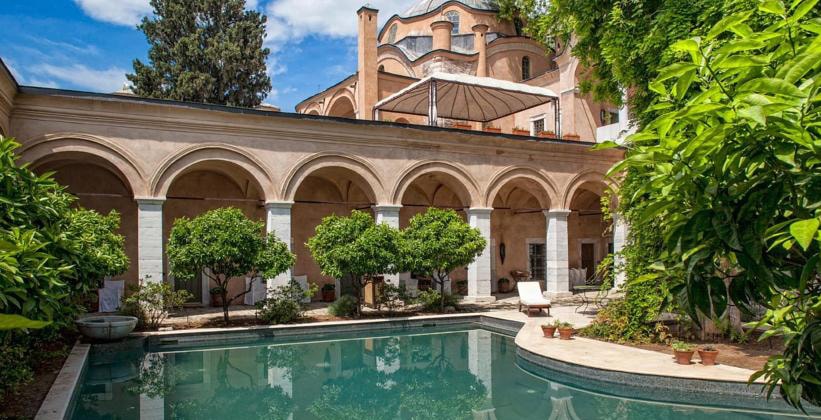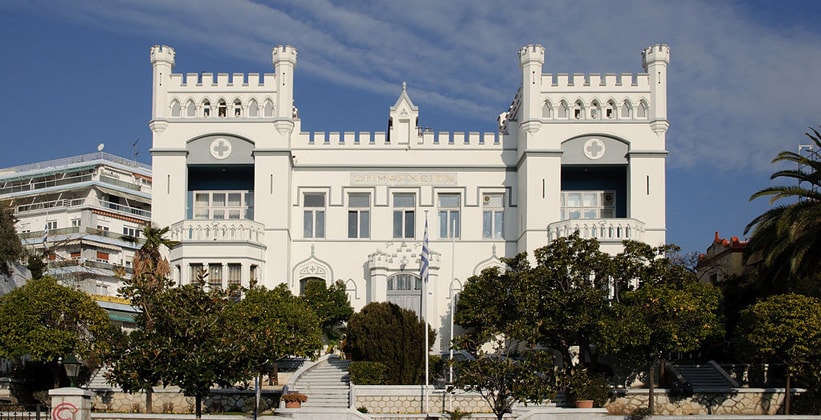Supported by the hills of the eastern foot of Mount Symbolo, Kavala is the second largest city in Macedonia and the second port of Northern Greece. In the 19th century, the city was unimaginably rich: tobacco grown in the vicinity of Kavala was loaded in its port on ships that transported it around the world. Although the efforts of Kavala to present itself to the world in the image of the "Azure City" - they say, we are on the shore of a spacious bay, and all that - look, perhaps, a little ridiculous, the city is still very pleasant, here a kind of center, in the areas surrounding the harbor, there are survivors tobacco stores. From the east, a picturesque citadel rises above the city, built on a long promontory, and a graceful Ottoman aqueduct stretches past modern buildings, leading to the old district on the rock.
In ancient times, the city was called Naples and for two hundred years, or even more, served as an important stop on the imperial road Via Egnatia and the first European port on the way of merchants and travelers returning from the Middle East. It was here that the apostle Paul landed on his way to Philippi during his first missionary trip to Europe. In subsequent centuries, the port and the fortress belonged in turn to the Byzantines, the Normans, the Franks, the Venetians, the Ottomans and (during both world wars) the Bulgarians. Kavala is one of the main ports of departure for Thassos and, to a lesser extent, for Samothraki and Limnos.
Arrival, information and accommodation in Kavala (Greece)
The main bus station is located at the corner of Metropolitan Chrysostom and Filikis Eterias, near the pier for ferries and hydrofoils going to. Taxis are a rich reddish-yellow color, but if you are in your own car, it is usually enough (only) to find a place to park in the car park on the waterfront, near the pier for connection with Thassos. On the main square of Eleftherias, you will find a branch of the state travel agency EOT, where you can make inquiries or buy tickets for the performances of the Philippi-Thassos summer festival, but nothing more. The area is surrounded by banks with ATMs.
Kavala airport is used by vacationers who have bought tickets to Thassos, as well as passengers inside the Greek air service from, the airport is 29 kilometers southeast. Car ferries to Thassos depart from Kavala almost every hour, from 6 am to 9 pm, and almost all go to the port of Skala Prinou (1 hour 15 minutes). During the season, the city is connected to the island by regular hydrofoil flights (30 minutes one way). Find out the details on the spot. Other ferries run several times a week, although the schedule, of course, needs to be clarified.
From the end of June to the end of August, theoretically, 5 flights a week go on (usually Monday-Wednesday, Friday and Saturday; 4 hours), although anything happens in different years: in some years, these flights start operating as early as (Orthodox) Easter, so find out the details. More reliable - four flights a week to Limnos (usually Tuesday, Thursday, Saturday and Sunday; 5 hours), out of season - only 2 flights. Most of the year, two or three of these flights reach various island and mainland ports, including Agios Efstratios, and Lavrion. Inquire about all flights at the port administration, and purchase tickets at agencies such as Zolotas and on the waterfront.
- Where to stay in Kavala (Greece)
Providing you with high quality hotel rooms for a high price in Kavala is not at all on the agenda. In addition to ordinary hotels, you are given a choice: one of the best hotels in , prices are appropriate, or exorbitantly inflating establishments, the owners of which, however, are quite accommodating in the off-season, and manage to negotiate a discount for a category, or even two.

Once in the city in the afternoon, for example, after getting off a charter flight, it would be better for you to get from the airport to Keramoti and take a ferry to Thassos, where the choice of hotels is much wider, and you can go to Kavala a day later. There is also an unusual hotel in Nea Karvali, 12 kilometers to the east. The nearest campsite is Irini (all year round) - on the coast 3 kilometers east of the port, bus number 2 runs. Anatoli campsite (May-September) with a swimming pool filled with salted water, on the western edge of Nea Peramos, in 14 kilometers west of Kavala.
1). Acropolis Hotel– The cheapest acceptable hotel in the city: managers speak English, rooms are large but not without pleasantness. Location: Venizelu 29;
2). Esperia Hotel– Decent hotel with air conditioning, good breakfast served on the terrace – ask for quieter rooms on the back side. Location: Eritru-Stavrou 42;
3). Institution Galaxy“The monstrous building from the 1960s contains perfectly acceptable rooms with wonderful views of the harbor. Good discounts in low season. Location: Venizelu 27;
4). Imaret Hotel– Masterfully converted monument of the Ottoman era: the building was donated to the city by its great benefactor Muhammad Ali. It is still officially owned by the Egyptian government, although it is now a luxurious hotel, every detail carefully thought out to please the most discerning guest, the silence broken only by the sound of water filling the swimming pool in the courtyard. Rooms and enfilades, in which students of Islamic schools lived in the 19th century, have been turned into modern, impeccable hotel accommodation, although the building itself has been preserved in its original form. Services include a traditional hammam with massage, Ottoman dishes in the restaurant and an indoor swimming pool. Location: Pulidu 6;
5). Nefeli Hotel– Right behind the Esperia Hotel. The hotel is not easy to describe: it is difficult to call it tempting, but it is quite suitable as a temporary shelter. Least expensive en-suite rooms in town and a lovely rooftop garden. Location: Eritru-Stavrou 50.
Sights of Kavala (Greece)
Although the Ottoman heritage in Kavala has been kind of abandoned, the wedge-shaped area of Panagia has retained a scattering of buildings from the 18th and 19th centuries and charming streets rising to the citadel. The most striking of them is the luxurious Imaret, looking at the harbor from Pulidu. This long, multi-domed structure initially served as a dining room and hostel for students studying Muslim theology. After decades of neglect, Imaret was magnificently refurbished and opened to the public in 2004 as a luxury resort hotel. This best-preserved piece of Islamic architecture in Greece was built in 1817 and presented to the city by Mohammed Ali, Pasha and founder of the dynasty that ended with King Farouk in 1952.
Further and higher on the cape, near the intersection of Pulidu and Mohammed Ali, there is a wonderful house in the Ottoman style - an Albanian family lived in this house, in which a baby was born in 1769 - the future ruler Mohammed Ali. The wooden lobbies, the stables on the ground floor and the harem room on the next floor have also been expertly restored and now serve as the halls of a top-class restaurant run by the same people as the Hotel Imaret. Nearby is a bronze monument: a beautiful equestrian statue of a great man, one of the most successful works of this kind in Greece. And from the Byzantine citadel (daily: summer 8:00-19:00, sometimes with a break for a siesta; winter 8:00-17:00; free of charge) wonderful views open up. In search of the road to the fortress, look for signs "Castle".
You can explore the ramparts, towers, donjon and cistern, and during the season the main courtyard of the fortress serves as one of the venues for the Philippi-Thassos Drama and Music Festival. From here, the Kamares aqueduct descends to the middle part of the city, built according to Roman models in the reign of Suleiman the Magnificent (1520-1566), and now rising above the traffic on the dress of Nikozar. Finally, across from the old town, across the harbour, there are three moderately interesting museums. In the Archaeological Museum (Tuesday-Sunday 8:30-17:00; 2 €) on Eritru-Stavrou upstairs, in the Abdera Hall, beautiful mosaics with dolphins and lilies are shown, and painted sarcophagi are exhibited in the adjacent hall dedicated to the colonies of Thassos.
Below, in the left rear gallery of the lower floor, a reconstruction of the Macedonian burial chamber was built with many terracotta figurines, on which antique paint and gold patterns survived - figurines from burials in Amphipolis. A little further and away from the sea, next to the very dilapidated tobacco warehouses in the Municipal Museum (Monday-Friday 8:00-14:00, Saturday 9:00-13:00; free of charge) at Philippu 4, except for stuffed birds, traditional clothes and kitchen utensils, there are a couple of interesting rooms with the work of the sculptor Polygnotos Vayis, who was born on the island of Thassos.

A block away, uphill, on Paleologu 4, there is the Tobacco Museum (Monday-Saturday 9:00-13:00; free of charge) could be of interest, but the exposition is very clumsily built and there are no explanations even in Greek, let alone English tablets, although many exhibits, such as old photographs and ancient cigarette packs, are definitely of historical value, and are simply curious. The prosperity of Kavala in the 19th century, achieved thanks to tobacco, is perhaps best evidenced by the fabulous facade of the Municipal Tobacco Warehouse (Dimotiki Kapnapotiki) - this is nearby, on the Kapnergati dress. The building has been carefully restored and turned into a shopping center which opened in 2007.
Food and drink in Kavala (Greece)
With food in Kavala, in general, it is better than with hotels, however, most of the establishments on the waterfront are snares put on tourists, and in order to find a fish tavern, which the locals go to, you need your own transport, you will have to drive along the coast to the east, leaving the city behind. The best strategy is to head up to the Panagia area, with lines of moderately priced taverns with outdoor tables punctuated by coffee bars that tempt you with good and reasonably priced grilled dishes and seafood.
One of the best bars is Old Town (Glaros), which is on Pulida, not reaching the taverns. On the pedestrian Ayio Nikolaou, behind the church of the same name, is Ethnik, a creatively designed venue that plays anything from Tom Jones to Jefferson Eaplane. Mao attracts noisy crowds of students. On the pedestrian Palama, parallel to Venizel, fashionable cafe-bars lined up.
1). Tavern Antonia– A traditional family tavern where good draft wine is served with full plates of fried squid. Location: Pulidu;
2). Institution To Athanato Nero“The best place on Pulida, true, the mussel saganaki is mediocre, but the white wine from Limnos is excellent. Location: Pulidu;
3). Institution Kanadhos– Fish dishes, homely atmosphere, the owners returned from Toronto, hence the name and English-speaking staff. Location: Pulidu;
4). Restaurant Mehmet Ali House– An expensive gourmet restaurant and at the same time an architectural monument of the 18th century (Ottoman cuisine). Location: Pulidu;
5). Tavern Panos Zafira– The most reliable waterfront tavern: good fish at reasonable prices. Location: Platia Caraoli Dimitriou;
6). Institution Tembelhanio– A cozy uzeri with a wide selection of delicious mezedes, Greek recordings and music from the Middle East. Location: Pulidu.
In contact with
